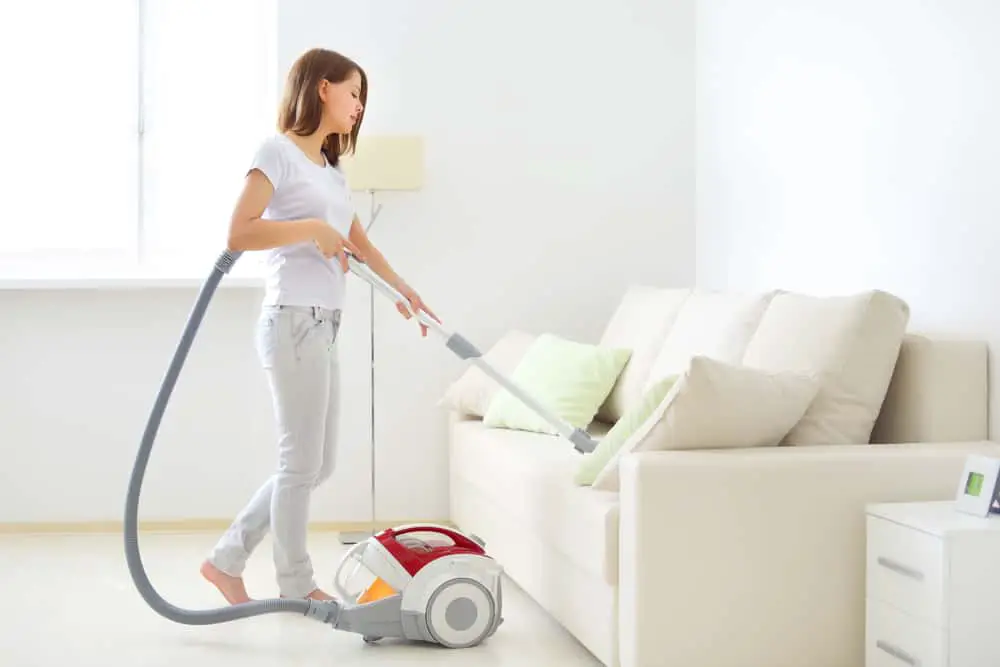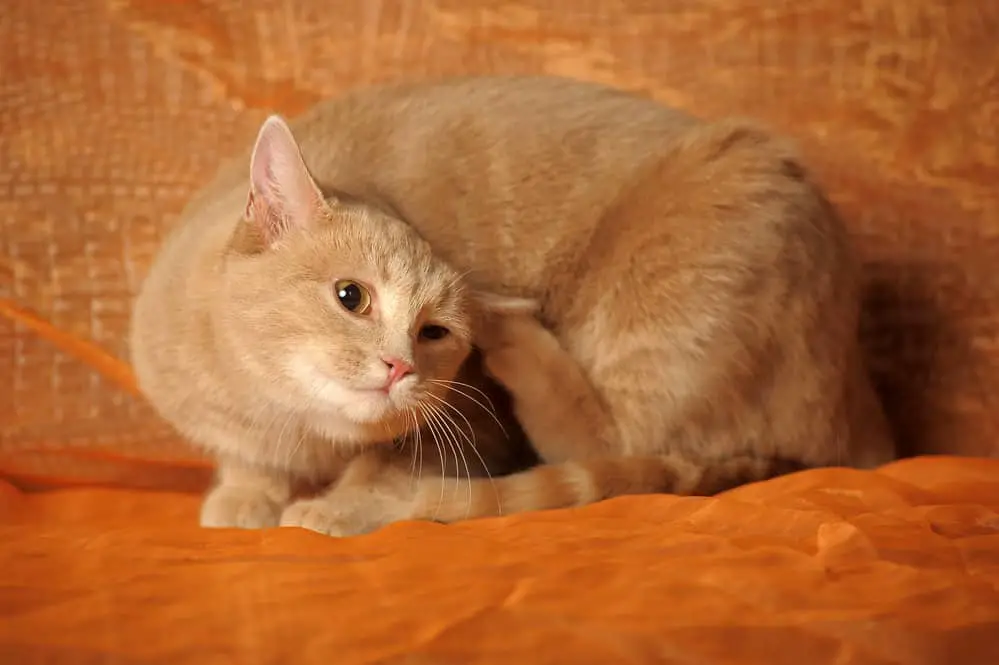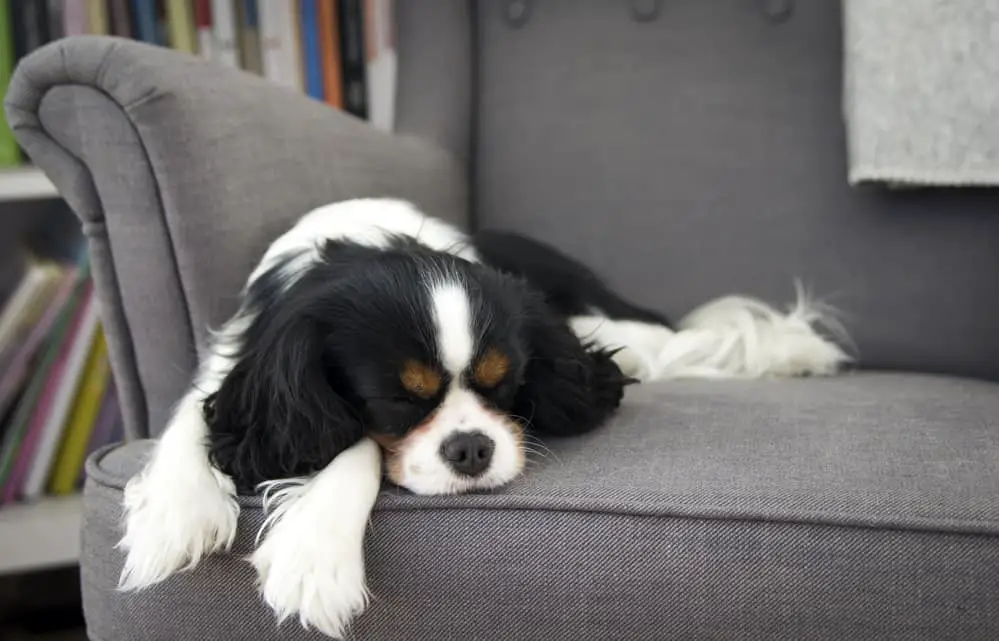When fleas enter your home, they will try to find a host they can live on. Adult fleas will seek other places to hide if a cat, dog, or another long-haired animal can’t be found. Once in these hiding places, like beds and couches, they can remain for weeks and lay eggs.
Flea infestations are the hardest to eliminate all the insects and pests you can carry inside. In almost no cases do fleas go away on their own, and swift action must be taken. One location that always has likely homes for fleas is the living room couch.
Do Fleas Hide in Couches?
It is extremely common for adult fleas, immature fleas, and flea eggs of every stage to be present inside of a couch. If the furniture isn’t hit with a vacuum and cleaned thoroughly with hot water regularly, it can become a breeding ground for fleas and flea larvae.
There are quite a few reasons why sofas are such hot spots for fleas to hide. Looking at why fleas choose couches to hide in can help you look for signs of fleas in your home. If you see these tiny pests, get rid of them fast to avoid painful flea bites and diseases from filthy flea dirt.
Continuous Contact with Humans and Animals:
Pets and people love to plop down on the sofa multiple times throughout the day. In some cases, the family couch has almost constant butt rotation. A female flea has plenty of time to dine on a blood meal; she needs to fertilizer her eggs
With a flea bite of blood, she can lay 50 eggs a day and tuck them deep down where they will be safe and secure. Flea collars and flea products can keep these insects off of pets but will not completely stop them from biting and continuing the flea life cycle away from the host.
Infrequent Deep Cleaning:

Rugs and carpets get full attention from a vacuum cleaner, and flea dirt or pests are eliminated regularly. Couches don’t get a deep cleaning very often, and flea eggs and flea dirt can accumulate over time. Flea dirt becomes food for flea larvae, allowing fleas to live inside your couch for years.
You will need to clean the cushions with hot soapy water, which can be difficult on upholstered furniture. You will also need to vacuum every surface. To get rid of fleas in the sofa, you will also need to vacuum the cracks and gaps repeatedly. It may take several days to get the immature stages of fleas and the rest of the flea life cycles out of the cracks in your couch.
A Stable Environment for Fleas to Live:
Living room sofas are often kept at a nice temperature so fleas will not die off as they would in a colder room during winter. This comfort can lead to the surfaces under the couch cushions becoming cozy homes for generations of fleas.
Blankets and bedding that come into contact with the couch can further spread flea infestation through your home. If those blankets and bedding end up on a mattress, you could be looking at a full home infestation in no time.
Dark Safe Corners and Gaps for Eggs to Develop:
Not only are the surfaces of a sofa good for fleas, but the color and dark areas of sofas can make it impossible to spot them. Getting into the gaps and corners of the couch with a vacuum can be tough, and so fleas can live inside indefinitely.
Trying to manually remove all the fleas can be tiresome and ineffective, so it is a good idea to use flea powder or diatomaceous earth, which is toxic to fleas and safe for pets. Pushing these into the gaps will kill fleas and make your vacuuming even more useful.
Can Fleas Survive on Furniture for Long?
The length of time a flea can live inside a sofa depends on which stage of its life cycle. A flea can either be an egg, larvae/pupa (immature stage), or an adult. Each flea stage can survive for a different length of time without a host in an ideal environment like a couch.
| Life Stage | Time Alive on Host | Time Alive on Couch |
| Egg | 1 to 10 days | 10 days max |
| Larvae | 4 to 18 days | 4 to 18 days |
| Pupa | 3 days | 1 year |
| Adult | 1 year | 1 to 2 weeks |
- Egg: Flea eggs are microscopic and translucent when first laid. They do not stay on host animals and fall wherever gravity takes them. If on a sofa, it can take up to 10 days for an egg to hatch. if it doesn’t hatch in that time frame, then it probably won’t. A female flea can lay up to 50 eggs a day.
- Larvae: At this stage, the larvae on a host will spend the next week or two eating flea dirt (feces) and blood to grow strong and create their cacoon. Flea larvae in a sofa may not have access to fresh blood but can still grow and survive on the flea dirt of the previous generation of fleas.
- Pupa: Once a cacoon has been spun, a flea can stay in a pupa for a very long time. On a host, it only takes as little as 3 days to transform into an adult flea. But when a suitable life form isn’t available, a flea in a pupa can go dormant for as long as a year. When vibrations, warmth, and carbon dioxide alert the flea of a viable host, it bursts out and hitches a ride.
How to Find Flea Eggs on Furniture?

There is a reason why fleas can take over a house so quickly; they are tiny. Flea eggs are microscopic and translucent when they are laid. You will need a magnifying glass and a good light to see these eggs in your furniture.
If you suspect you have fleas, you can confirm them in a few different ways. The first thing to do is track down some adult fleas. I use a sheet of white paper and set it on a surface where I think fleas live. I know I have fleas if black specks sporadically pop on and off the paper.
Using this method in several other locations, I try to narrow down where the highest density of adult fleas is. Once I have an idea of the source of the major flea infestation, I use a magnifying glass to track down some eggs to see what I need to do to get rid of these invaders.
How to Eliminate Fleas in a Couch?
If fleas are on your couch or attached to any furniture in your house, you will want to take immediate action to rid yourself of them. Fleas bite, and the bites itch. You can get diseases from flea infestation, and overall it is a terrible experience to be living with fleas.
In most cases, fleas will not go away on their own, even if you treat the pets and remove the source that brought fleas into your home in the first place. The only way to completely eliminate fleas is to attack them from all sides.
- Clean Pets and Use Flea Prevention Product: Wash pets with flea-killing soaps and make sure it prevents reinfestation afterward. Look for natural oils like peppermint and lemongrass that are safe for animals and toxic to fleas. Commercial flea and tick products have been known to kill pets; please use caution!
- Clean All Fabric and Bedding: Anything that can be washed with hot soapy water should be. Washing clothes, bedding, cushions, pillows, carpets, and curtains can remove a significant portion of the flea population. Make sure to store the fabric in an air-tight bag until the rest of the house is clean, or the fleas will jump right back on.
- Vacuum All Surfaces and Rooms: Go through the house with a vacuum cleaner and try to hit every surface that wasn’t washed and cleaned with hot water. The more times you go over it, the more fleas you will capture. Make sure to dispose of the dust bag immediately and far from your house to avoid flea re-infestation.
- Flea Powder or Diatomaceous Earth (D.E): If you have no children or pets at home, you can use chemical flea powders to kill any remaining pests. After letting it sit for the time on the instructions, vacuum all the powder up. Keep an eye out for fleas and repeat as necessary. If you have pets and children, use D.E. instead, this may take longer but is much safer and still effective.


